

Jean-Luc Picard. Casting and design[edit] As the series progressed, Stewart exercised more control over the character's development.
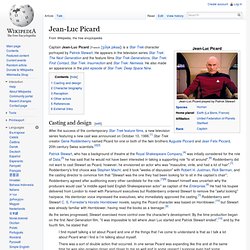
By the time production began on the first Next Generation film, "it was impossible to tell where Jean Luc started and Patrick Stewart ended",[10] and by the fourth film, he stated that I find myself talking a lot about Picard and one of the things that I’ve come to understand is that as I talk a lot about Picard what I find is I’m talking about myself.There was a sort of double action that occurred. In one sense Picard was expanding like this and at the same time he was also growing closer and closer to me as well and in some respect I suppose even had some influence on me. I became a better listener than I ever had been as a result of playing Jean Luc Picard because it was one of the things that he does terrifically well.[6] Stewart stated, however, that he is not nearly as serious or brooding as his alter ego.[11] James T. Kirk. William Riker. John Harriman. List of minor recurring characters in Star Trek: The Next Generation. Demora Sulu.
This article lists characters of Star Trek in their various canonical incarnations.

This includes fictional major characters and fictional minor characters created for Star Trek, fictional characters not originally created for Star Trek, and real-life persons appearing in a fictional manner, such as holodeck recreations. List of minor recurring characters in Star Trek: The Next Generation. List of minor recurring characters in Star Trek: The Next Generation. Data (Star Trek) Lieutenant Commander Data (/ˈdeɪtə/ DAY-tə) is a character in the fictional Star Trek universe portrayed by actor Brent Spiner.
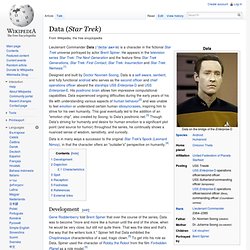
Geordi La Forge. Concept and development[edit] Lt.
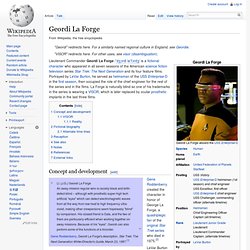
(J.G.) Geordi La Forge An away-mission regular who is racially black and birth-defect blind – although with prosthetic super-high tech artificial "eyes" which can detect electromagnetic waves from all the way from raw heat to high frequency ultra-violet, making other crewpersons seem hopelessly "blind" by comparison. His closest friend is Data, and the two of them are particularly efficient when working together on away missions. Because of his "eyes", Geordi can also perform some of the functions of a tricorder. Gene Roddenberry, Geordi La Forge's description, Star Trek: The Next Generation Writer/Director's Guide, March 23, 1987.[1] Worf. Casting[edit] Worf was at first not intended to be a regular character, since Gene Roddenberry wanted to avoid "retreads of characters or races featured prominently in the original Star Trek series", and so the June 1, 1987 cast portrait did not include Worf.[2] Several "tall, slim, black actors" auditioned for Worf before Michael Dorn came along, walking into the audition in character and not smiling.[3]
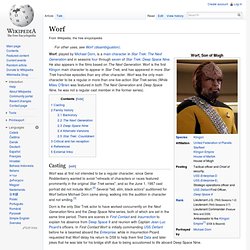
Beverly Crusher. Casting[edit] Gates McFadden was reluctant to accept the role of Dr.
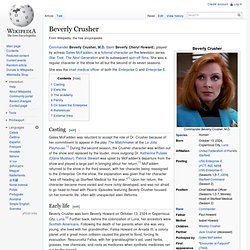
Crusher because of her commitment to appear in the play The Matchmaker at the La Jolla Playhouse.[1] During the second season, the Crusher character was written out of the show and replaced by the louder, more outgoing Dr. Katherine Pulaski (Diana Muldaur). Patrick Stewart was upset by McFadden's departure from the show and played a large part in bringing about her return.[1] McFadden returned to the show in the third season, with her character being reassigned to the Enterprise. On the show, the explanation was given that her character "was off heading up Starfleet Medical for the year. Deanna Troi. Depiction[edit] Deanna Troi was born on March 29, 2336, near Lake El-Nar, Betazed.[2] Deanna's parents are Betazoid Ambassador Lwaxana Troi (portrayed by Majel Barrett), and deceased human Starfleet officer Lt.
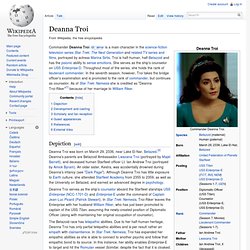
Ian Andrew Troi (portrayed by Amick Byram). An older sister, Kestra, was accidentally drowned during Deanna's infancy (see "Dark Page"). Although Deanna Troi has little exposure to Earth culture, she attended Starfleet Academy from 2355 to 2359, as well as the University on Betazed, and earned an advanced degree in psychology. Montgomery Scott. Development and portrayals[edit] Doohan was cast as the Enterprise engineer for the second Star Trek pilot, "Where No Man Has Gone Before" (1966) on the recommendation of that episode's director, James Goldstone, who had worked with him before.[4] The character almost did not make it to the show after series creator Gene Roddenberry sent Doohan a letter informing him, "We don't think we need an engineer in the series".
Pavel Chekov. Origin[edit] After Paramount Television signed Koenig to a contract because of the number of fan letters he received as Chekov, Roddenberry wrote in another memo "Kirk and Spock and the others actually seem rather 'middle aged' to the large youthful segment of our audience. We badly need a young man aboard the Enterprise -- we need youthful attitudes and perspectives. Chekov can be used potently here". He envisioned Chekov as a brilliant officer whose "youthful inexperience and tactlessness, his youthful drive to prove himself, his need of approbation, his quite normal youthful need for females, and all of that, keep getting in his way", whom Kirk could mentor.[6]